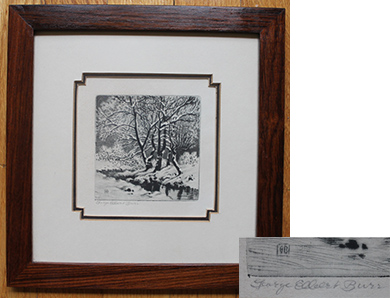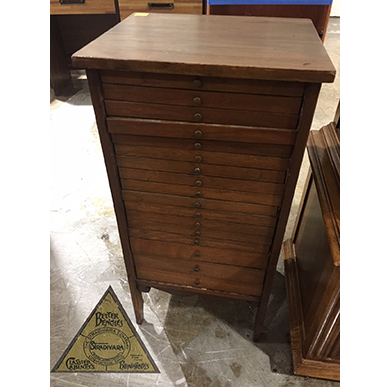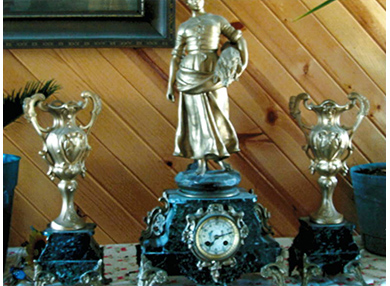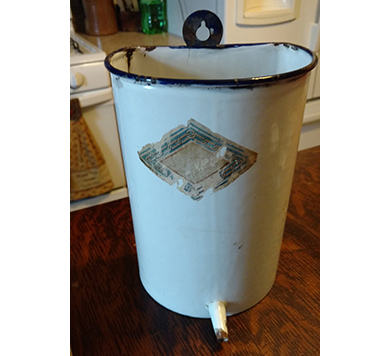 |
|
|||
 |
 |
|||
RINKER ON COLLECTIBLES — Column #1669 Copyright © Harry Rinker, LLC 2018 Questions
and Answers
QUESTION: I recently paid $15.00 for a lot of frames and a few pieces of framed artwork. I bought the lot because of two picture frames and a framed drypoint etching that I wanted. The drypoint etching has a pencil signature of “George Elbert Burr” in the lower left corner below the etching. A square with the initials “GB” is in the lower left corner of the etching. The etching is doubled matted and framed. The frame measures 9-inches by 9 1/4-inches. The square matt opening measures 4 3/4 inches. The etching shows a line of snow-covered, leaves-barren trees along a stream. There is no title information. Although professionally matted, the back contains two pieces of blue duct tape holding the print package in the frame. What history can you provide about the piece and its potential secondary market value? – TB, Kent, Ohio, Email Question 
ANSWER: George Elbert Burr, an American printmaker and painter, was born in 1859 in Monroe Falls, Ohio. He studied for one semester at the Art Institute of Chicago, at the time famous for teaching printmaking. As a commercial artist his works appeared in Harper’s, Scribner’s Magazine, and other leading publications of the late 19th century. After spending four years making over 1,000 etchings of a jade collection owned by the New York Metropolitan Museum, Burr traveled throughout Europe for the next five years. When he returned to the United States, he experienced an attack of the flu that forced a move to Denver, Colorado. During the summer at a cabin studio, he produced drypoint etchings of Rocky Mountain scenes. In 1910, he built a home and studio in Denver. In 1924, Burr moved to Phoenix, Arizona, where he produced drypoint etchings of dessert and other western scenes. He died in 1939. Burr’s drypoint etchings were often sold in folio form. The drypoint etchings in the folio often focused on a single theme. While attempting to identify the specific drypoint etching you acquired, I encountered over half a dozen different etchings of snow-covered trees in a winter forest. Burr apparently kept his titles simple. Snow on Trees and Winter Snow Covered Trees are two examples. I did find an exact match for the drypoint etching you own—Winter Creek Trees. While many of Burr’s drypoint etchings were untitled, others had the title information printed below the etching. It is a common practice for framers to mat out this information. Another practice is to cut down the paper to fit a particular frame size. When valuing printed material in a frame, there are two considerations. First, what is the value of the item unframed? Second, what enhanced value does the framing presentation add? Assuming your print is not cut down and the paper remains white (not discolored by age or an acidic backing), the print’s value is between $35.00 and $45.00. Professionally framed, the value jumps to $75.00 to $90.00. The Golden Age for collecting drypoint etchings was the 1920s through the 1950s. In the course of my career, I have seen several private collections assembled during that period. Etchings from the “Chicago School” were highly prized. Collecting etchings fell out of favor by the end of the 20th century. Today, they represent an inexpensive entry point for individuals who want to assemble an art collection. QUESTION: I own a wooden filing cabinet with 17 flat drawers. The bottom three drawers are slightly taller than the fourteen drawers above them. The cabinet has a triangle label with a central circle. At the top is a script “Better Benches” above the inner circle. In the lower left is a script “Classier Cabinet” (the two words sharing a common “C’) outside the circle. In the lower right is “Know for Tone Phonographs” outside the circle. The circle is double lined. Between the lines is “THE STRADIVARA COMPANY / COSHOCTON, OHIO.” “STRADIVARA” is centered across the inside of the circle beneath which is a small reverse arch banner in which is “WOOD CRAFTSMEN.” What used did this cabinet serve? What is it worth? – LR, Gaithersburg, MD, Email Question 
ANSWER: When I first saw the images of your cabinet that accompanied your email, my initial thought was a dental or medical cabinet. While normally painted white to signify “sanitized,” some were made in a wood finish or later stripped down and refinished to make them more appealing to buyers. Once I saw the picture of the label, I know exactly what you have. You own a sheet music cabinet. The former Boston Piano Company left Wooster, Massachusetts, around 1902 for Coshocton, Ohio. Upon arrival, it became the Compton and Price Piano Company. When phonographs became the rage, Compton and Price began manufacturing phonographs around 1916. The company built the cabinets and purchased the mechanisms for outside suppliers. They marketed their phonographs under the Stradivara brand name. The company still was operating in the mid-1920s. Sheet music cabinets were common accessories for pianos. The number of music sheets that could be stored in a piano seat was limited. Given the skilled workers employed at a piano company, it was easy enough to spinoff a sheet music cabinet and bench division. “Better Benches” in the label stands for better piano benches, not other models. Some individuals confuse sheet music cabinets with music box disc cabinets. The latter are smaller, and the drawers are higher. Music box disc cabinet were designed so that the music box rested on top of the cabinet. The value of your sheet music cabinet does not rest in its ability to store sheet music. Rather, it makes a wonderful jewelry cabinet or paper ephemera storage unit. Its secondary market value is between $250.00 and $300.00. QUESTION: I have a three-piece garniture set. The centerpiece is a marbleized base with a clock with an enamel face in the center. The clock has a floral ormolu surround. The back of the clock is marked “Medaille-Dor /Samuel/ Marti / Paris 1900.” The clock does not work. There are applied ormolu pieces on the sloping side of the base. The feet also are ormolu. The style is that of Louis XVII. Resting on top of the base is a gold painted sculpture of a peasant woman holding a sheaf of wheat and standing on a round base. There is a label reading “La Glaneuse Par A. J. Scotte.” An “A. J. Scotte” signature also appears near the woman’s right foot on the round base. The two flanking pieces have a marbleized base, similar ormolu feet, and a Louis XVII-style gold painted urn. I would be grateful for any information you can provide. – LK, Ravenna, OH, Letter 
ANSWER: “La Glaneuse par A. J. Scotte” translates as “The Gleaner by A. J. Scotte.” A. J. Scotte (1867 to 1925) was a French sculptor. After an exhaustive internet search of Scotte’s sculptures, I found none that matched the sculpture atop your clock base. There are two possibilities. The first is that Scotte created a sculpture that was then mass-produced for use in the garniture set. The second is that the company knocked off Scotte’s style and created this pseudo-Scotte work. Samuel Marti Medalle D’Or Paris made clock movements and sold them to various manufacturers. They were used for a wide range of clock types from mantel clocks to garniture set clocks. Used mechanisms sell on eBay for around $50.00. Your garniture set dates from the early twentieth century. Although ornate, it is not of high quality. The garniture set is more for show than anything else. The fact that the clock does not work impacts the value of the set. It has more decorative/display value than collector value. Any offer above $100.00 is more than fair. Given modern tastes, it is a tough sell at any price. QUESTION: I recently purchased a white enamel oval bucket with a spout on the bottom. It measures 8-inches high, 6-inches wide, and 4-inches front to back. The top has a round hanger so that it can mount to a wall. It has a diamond shaped label but I cannot read it. What is it? – JP, State College, PA, Email Question 
ANSWER: Your question falls into the “my best guess” category. My first guess was that it hung over a wash basin. The spout most likely had a cap of some sort at one point. My second guess was a water container for use in the field or a barn. The answer is neither. After numerous internet keyword searches, I stumbled across an image for an enamel douche or enema container. The example I found was not an exact match but it closely resembled the container you own. Once I knew this, I did an internet search using “Vintage Enamel Enema Container.” I was astonished at the variety I found. I learn something new every day. Harry L. Rinker welcomes questions from readers about
collectibles, those mass-produced items from the twentieth and twenty-first centuries.
Selected letters will be answered in this column.
Harry cannot provide personal answers.
Photos and other material submitted cannot be
returned.
Send your questions to: Rinker on Collectibles, 5955 Mill
Point Court SE, Kentwood, MI 49512.
You also can e-mail your questions to
harrylrinker@aol.com.
Only e-mails containing a full name and mailing address
will be considered.
You can listen
and participate in
WHATCHA GOT?, Harry’s
antiques and collectibles radio call-in show, on Sunday mornings between 8:00 AM
and 10:00 AM Eastern Time.
If you
cannot find it on a station in your area,
WHATCHA GOT?
streams live on the Internet at www.gcnlive.com.
|
||||